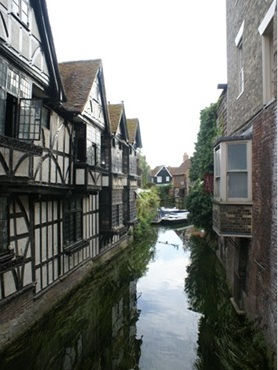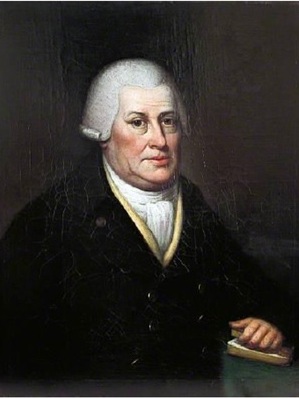JOHN KELLAWAY OF DORSET – THE START OF THE CANTERBURY SILK WEAVERS?John Kellaway was born in Broadwey, South Dorset. He was the son of Henry and Alice Kellaway and a younger brother of William Kellaway, the commander of the Luxborough Galley (a slave ship) which was lost by fire at sea in 1727.HENRY KELLAWAY & ALICE Broadwey, Dorset Clothier d.08 May 1743 d.28 Jul 1754 William 18 Sep 1699 m.Ann. Commanded the Luxborough Galley Died 1727 Newfoundland. Henry 01 Nov 1699 m.Mary Farewell Brewer Ralph 06 Nov 1701 1st Mate of the Luxborough Galley. Died in the fire, 1727. Robert 13 Nov 1705 d.22 Sep 1707 Elizabeth 14 Oct 1707 John 09 Mar 1709 Apprenticed to Nicholas Haskoll, clothworker, 04 Oct 1726 London Mary 08 Mar 1711 Ann c.1712 Lucy 14 Feb 1714 d.17 Aug 1794, 80, SpinsterWhile some of the older sons took to the sea John signed apprentice indentures in London in 1726. “This indenture witnesseth that John Kellaway son of Henry Kellaway of Broadwey in the county of Dorset, clothier doth put himself apprentice to Nicholas Haskoll, Citizen and clothworker of London, to learn his art and with him (after the manner of an apprentice) to serve from the Day of the Date hereof unto the full end of the term of seven years, from thence next following – – ” There follows a series of conditions for the apprentice′s good behaviour and duties one of which prevents him from marriage during his apprenticeship. Conditions are also placed upon the master to provide instruction, food, clothing and lodging etc. The Indenture is signed and sealed on the “Fourth Day of October in the Thirteenth year of the Reign of our Sovereign Lord King George, of Great Britain, etc Annoque Dom. 1726.” Nicholas Haskoll lived in Aldgate and in the Parish of St Michael Bassishaw where he paid taxes during the early 1700s and had earlier apprentices. This parish is also stated as his on his marriage to Sarah Hore 23 May 1712 in St Mary Whitechapel both had been married before. Nicholas died in 1732 which would be before the apprenticeship of John ended. He left bequests to two brothers and his estate to his brother Joseph Haskell. There is no record of what became of the apprentice, he may have finished his term with the brother or just been dismissed. So what became of John Kellaway? He is not recorded back in Broadwey so perhaps he stayed on in London. If we examine the City of London records we find a John Calaway (all City records are spelled with a C at that time) and family. JOHN CALAWAY & PHILLIS m.? d.? d.01 Feb 1795 Canterbury John? 1739 m.Elizabeth Daws 09 Nov 1761 Stepney Stephen 22 Sep1742 St Botolph Aldersgate Richard 31 Jul 1745 St Botolph Aldersgate As is clear there is no marriage found so far for John and Phillis, no burial for John Callaway nor is there a baptism for John 1739. But later we have a possible family for the John b.1739: JOHN CALLAWAY & ELIZABETH DAWS m.09 Nov1761 Stepney Elizabeth Ann 29 Aug 1762 Stepney John 28 Feb 1764 Stepney Mary 16 Feb 1766 StepneyNow this family went to Canterbury in Kent and we find them there again. JOHN CALLOWAY & ELIZABETH DAWS m.09.11.1761 Stepney Master of Silk Weavers d.19 Jul 1807 Will, 68 d.26 Sep1799 Elizabeth Ann 29 Aug 1762 Stepney John 28 Feb 1764 Stepney m.Elizabeth Parker 27 Dec 1785 Mary 16 Feb 1766 Stepney m.James Ridout 01 Feb 1787 Licence 30 Jan 1787 father John, Silk Manufacturer Ann 1769 m.William Nutt 03.12.1790 Licence 01 Dec 1790 (coach master) Sarah 26 Jul 1772 Canterbury Charlotte 21 Dec1777 Canterbury m.John Heritage 17 Dec 1800 Licence 15 Dec1800 d.after 1851 Since Phillis Callaway (an unusual name) died in Canterbury in 1795 aged 85 it is perhaps not unreasonable to assume she went there with a son John. Can all these links be proved? No they can′t be proved but seem very likely especially if we add in this record: Death, January 4, 1795 – Mrs. CALLAWAY, mother of Mr. John CALLAWAY, senior, silk manufacturer of that city. John Callaway arrived in Canterbury from London about 1768 and there the Callaway family flourished as silk weavers. Silk weaving had been a prominent business in the city since Elizabethan times. In 1769 John and Thomas Ridout, father of his future son–in–law James Ridout, founded a Friendly Society (which later became the Historical Society and then the Canterbury Philosophical and Literary Association) for his fellow weavers.
In 1778 John Callaway, silkweaver, became a freeman by redemption (i.e. he paid) This was a period when the silk weaving trade was in rapid decline in Canterbury due to increasing competition from cheaper imported silks, the availability of cotton materials and the American War of Independence. John Callaway became master of the Canterbury weavers company and is believed to have travelled north to inspect the cotton mills, and inspect the processes used to combine the threads on the new machines. Early in the 1780s John Callaway erected a mill to the west of Rough Common Road in Stock Wood, but the small stream had insufficient flow so he asked for permission to build another mill in Shaol Oak, Hackington, in the back stream leading from Dean′s Mill into the River Stour a little below Barton Mill. This water mill was for making cotton twist, which Calloway then combined with the silk on his looms. In October 1790 the commissioners looked at the site and agreed he could build his mill. “He discovered a method of mixing Sir Richard Arkwright′s level cotton–twist with his looms of silk warps, by which contrivance he introduced to the public a new manufacture, that afforded employment, and consequently subsistence, not only to the poor unemployed workmen in Canterbury, but in other parts of England also. This beautiful new article, was called Canterbury muslin – –.” (The History and Topographical Survey of the County of Kent: Edward Hasted (1800)) Thus John Callaway became the inventor of the Canterbury or Chambery Muslins for which there was great demand all over England. Sadly after years of prosperity, fashions changed and by 1800 only 10 weavers remained in the city. Callaway ceased using his mill by 1798, but his will confirmed continued ownership of the mill and of his shop which was adjoining the Prince of Wales Public House in St Alphage Street. John Callaway′s obituary in the Kentish Gazette after his death on 17 July 1807 stated that he was “an ingenious and formerly eminent silk weaver, from whose looms some of the most beautiful and costly fabrics have been produced and adorn the palaces of royalty.” Hasted wrote that ’in the year 1789 I saw in Mr Callaway′s silk looms, the richest and most beautiful piece of silk furniture for the Prince of Wales Palace of Carlton House’ In the Universal Magazine 1807 it was reported: Died, August, at Canterbury, at his house, Northgate Street, Canterbury, in the 69th year of his age, Mr. John Callaway, sen. an ingenious and formerly eminent silk weaver, from whose looms some of the most beautiful and costly fabrics have been produced that adorn the palaces of royalty. On the abundant introduction of cottons, and consequent decline of the silk trade, he successfully invented that mixture of those materials, known by the names of Canterbury damasks, Chambery and Canterbury muslins, Etc. Of a strong, though uncultivated mind, he was indefatigable in the acquirement of science, and being equally desirous of communicating what he thought good to others, he founded, in 1768, an Historical Society, at first principally among that class of ingenious mechanics with whom he was associated, but which has been since extended and strenuously supported by his mental knowledge and personal abilities.
Refs: BMD London Metropolitan Archives BMD Canterbury BMD Dorset Ancestry.com Edward Hasted, ‘Canterbury: Silk and other manufactures’, in The History and Topographical Survey of the County of Kent: Volume 11 (Canterbury, 1800), pp. 91-98 http://www.british-history.ac.uk/survey-kent/vol11/pp91-98 |

